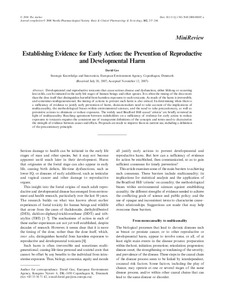Establishing evidence for early action: the prevention of reproductive and developmental harm

Basic and Clinical Pharmacology and Toxicology
2008
102
2
257-266
early diagnosis ; exposure ; prevention ; reproductive hazards ; toxic substances
Occupational risks
English
Bibliogr.
"Developmental and reproductive toxicants that cause serious disease and dysfunction, either lifelong or occurring late in life, can be initiated in the early life stages of human beings and other species. It is often the timing of the dose more than the dose itself that distinguishes harmful from harmless exposures to such toxicants. As much of the harm is irreversible, and sometimes multigenerational, the timing of actions to prevent such harm is also critical. In determining when there is a sufficiency of evidence to justify early prevention of harm, decision-makers need to take account of the implications of multicausality, the methodological biases within environmental sciences, and the need to take precautionary, as well as preventive actions to eliminate or reduce exposures. The widely used Bradford Hill causal 'criteria' are briefly reviewed in light of multicausality. Reaching agreement between stakeholders on a sufficiency of evidence for early action to reduce exposures to toxicants requires the consistent use of transparent definitions of the concepts and terms used to characterize the strength of evidence between causes and effects. Proposals are made to improve those in current use, including a definition of the precautionary principle."
Digital
The ETUI is co-funded by the European Union. Views and opinions expressed are however those of the author(s) only and do not necessarily reflect those of the European Union or the ETUI.